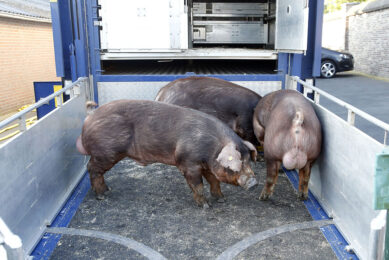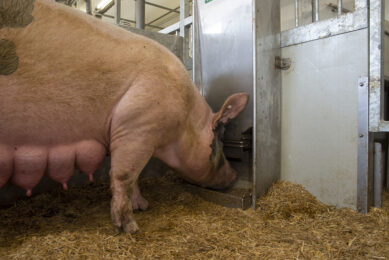New Feet First book examines sow lameness
A new book offering an illustrated view of the causes and effects of sow lameness is now available for the swine industry.
The book, An Introduction to Sow Lameness, Claw Lesions and Pathogenesis Theories, was developed by members of the Feet First® team and is available from Zinpro Animal Nutrition. The book explores methods to reduce the prevalence of lameness in commercial operations through lesion assessment, nutrition, gilt selection and corrective measures such as trimming.
©
“This book is a culmination of the Feet First team’s understanding of this important issue at this point in time,” says Max Winders, Zinpro Corp. director, international sales and marketing. “We see this book as just the start of a long-term effort, and we expect to expand it in the future as we gain knowledge related to swine lameness.”
©
A number of Feet First experts collaborated to produce the 44-page book. The late Pete Ossent, DVM and veterinary pathologist at the University of Zurich, Switzerland, took a lead authorship role. He guided the creation of several anatomical illustrations of the pig’s foot. He also developed a section on lameness pathways, and he authored a 21-page chapter on lesion identification, pathogenesis and treatment. Nine common lesions are documented in this chapter, using more than 50 photos in both field and clinical settings supplied by Ossent and Zinpro.
©
University of Minnesota Assistant Professor and Feet First team leader Dr. John Deen authored a chapter in the book on lameness prevalence and economics. He explains that lameness is often underestimated, and he outlines methods in the book to help identify the extent of lameness in a herd.© In addition, lost productivity in an operation due to lameness is costly, he says, and there is often a significant revenue opportunity associated with reducing the prevalence of lameness in a herd.
©
Ken Stalder, Ph.D., Professor of Animal Science at Iowa State University, is the author of a chapter on reducing lameness by selecting gilts with traits that will not predispose them to lameness. This helpful section utilizes 24 original illustrations of traits in gilts that are either desirable or that should be selected against. Given that lameness entering the farrowing crated dramatically increases the odds of early removal, it simply makes sense©©to select gilts with traits that are likely to reduce the incidence of lameness, Stalder says.
A chapter on reducing lameness through nutrition was authored by Dr. Mark Wilson, reproductive physiologist, Zinpro Corp., and Dr. Terry Ward, director, research and nutritional services, Zinpro Corp. This section discusses nutrients from water to energy to trace minerals, and their effect on lameness.
©
Finally, managing lameness through claw trimming is explained and illustrated in a four-page chapter authored by Sarel van Amstel, DVM and professor, College of Veterinary Medicine, University of Tennessee. Trimming has been shown to benefit sows that experience lameness caused by unequal weight bearing on overgrown toes and dew claws.
©
Launched nearly four years ago and sponsored by Zinpro, the Feet First team is composed of a select group of international researchers, veterinarians and nutritionists committed to further advance the swine industry through the identification and prevention of lameness. The group’s more recent findings will be presented during the Second International Feet First Sow Lameness Symposium, which will be held in Minnesota later this year.
 Beheer
Beheer








 WP Admin
WP Admin  Bewerk bericht
Bewerk bericht